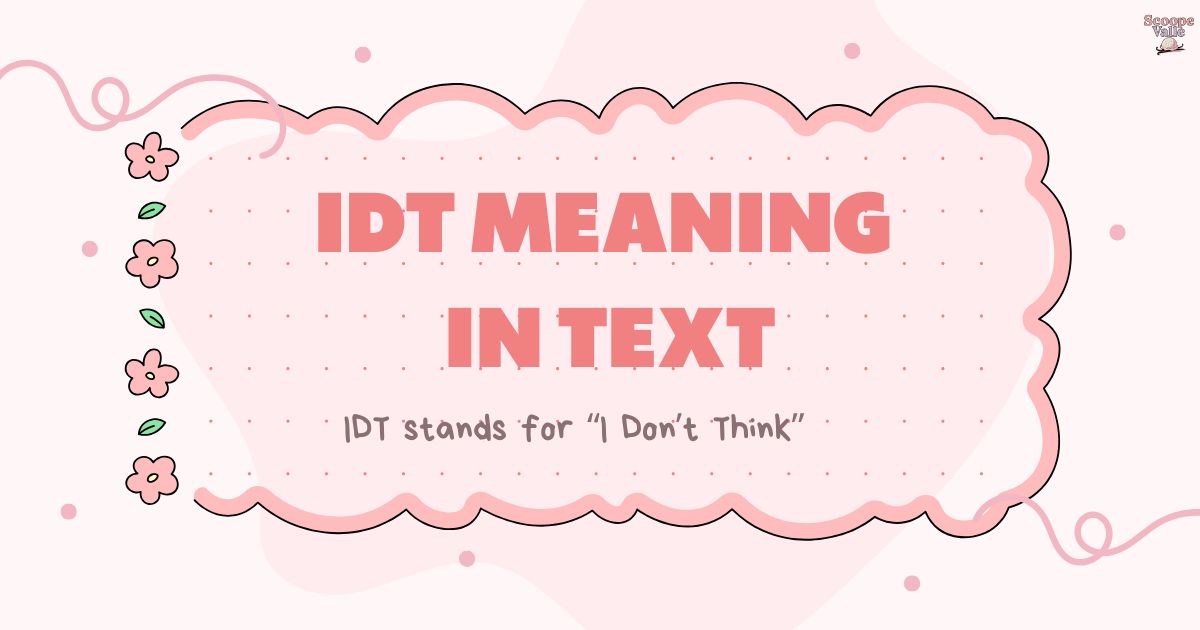In today’s fast-paced digital world, online communication has evolved with abbreviations, acronyms, and slang taking center stage. One such acronym that you might have come across is “IDT.” Whether you’re texting, social media-ing, or gaming, it’s essential to understand what IDT stands for. In this guide, we’ll break down everything you need to know about IDT, from its definition to usage in various contexts.
Definition & Meaning
IDT stands for “I Don’t Think.” It is an acronym used to express doubt, uncertainty, or disagreement with something. IDT is commonly used in informal text-based communication such as texting, social media, and gaming, to keep conversations quick and efficient.
For example:
Friend 1: “Do you think we’ll be able to finish the homework tonight?”
Friend 2: “IDT, we still have so much left to do.”
In this case, Friend 2 uses IDT to convey doubt about completing the homework, showing they don’t believe it’s possible.
Background & History
Abbreviations like IDT came into popular use during the early days of texting and instant messaging. In the 2000s, the need to type quickly on small phone screens and within character limits led to the creation of acronyms like IDT. These abbreviations have since become a key feature of online communication.
IDT became widespread with the rise of messaging platforms such as MSN Messenger, AIM, and later, social media apps. Over time, it became an essential tool for digital communication, especially among younger generations, who have adopted it into their everyday language.
Also read: NGL Meaning in Text: A Complete Guide to Understanding (Updated)
Usage in Various Contexts
IDT is used in many types of conversations, from casual texting to social media and gaming discussions. Let’s explore the different contexts where IDT can be applied:
1. Texting
Texting is one of the most common places where you’ll see IDT used. It’s a quick and easy way to express doubt or uncertainty. For example:
Person A: “Do you think it’ll be too late to call her now?”
Person B: “IDT, it’s already past 9 PM.”
In this instance, Person B uses IDT to express their doubt about the appropriateness of calling late at night. IDT is a convenient shorthand that saves time while keeping the conversation going.
2. Social Media
Social media platforms such as Twitter, Instagram, and Facebook are prime places to encounter IDT. Whether you’re making a post or commenting on someone else’s, IDT helps you convey a quick opinion or doubt.
Tweet: “IDT this new restaurant deserves all the hype, the food was too salty.”
Here, IDT is used to share a skeptical opinion about a new restaurant, expressing that the reviewer doesn’t think the place lives up to its reputation.
3. Gaming
IDT is also common in the gaming world. It’s used when players express doubt about their chances of winning or the strength of their opponents. Here’s an example:
Player 1: “Can we win this round?”
Player 2: “IDT, their team is too powerful.”
In this gaming scenario, Player 2 uses IDT to express doubt about winning the match due to the opposing team’s strength. It’s a quick and easy way to communicate uncertainty in the middle of the game.
4. Casual Conversations
Casual conversations among friends or family are another place where IDT is used. It can express a lack of certainty about something in a nonchalant way. Here’s an example:
Friend 1: “Do you think we should go on the hike this weekend?”
Friend 2: “IDT, the weather looks bad.”
In this conversation, Friend 2 uses IDT to express doubt about going hiking, indicating that the weather isn’t suitable for an outdoor activity.
Common Misconceptions & Clarifications
Some people mistakenly think IDT means “I Didn’t Think,” but that’s not the case. The correct meaning of IDT is “I Don’t Think,” which expresses doubt, disagreement, or uncertainty. While “I Didn’t Think” might make sense in some cases, it’s not the standard interpretation.
Another misconception is that IDT can be used in formal or professional writing. However, it’s a casual abbreviation that should be reserved for informal conversations. Using it in emails, reports, or any professional communication could come off as unprofessional.
Similar Terms & Alternatives
IDT is not the only shorthand used in digital conversations. Several other abbreviations express similar ideas, though each has a distinct meaning. Here’s a quick comparison:
| Term | Meaning | Context |
|---|---|---|
| IDK | I Don’t Know | Expressing uncertainty |
| IDC | I Don’t Care | Expressing indifference |
| IMO | In My Opinion | Expressing personal opinion |
| TBH | To Be Honest | Expressing honesty or sincerity |
These terms are often used interchangeably depending on the context. For instance, while IDT expresses doubt or disagreement, IDK expresses uncertainty, and IDC conveys a lack of concern.
How to Respond to This Term
When someone uses IDT in a conversation, your response will depend on the tone and context. Here are some possible responses:
1. Casual Response
If IDT is used in a casual conversation, you can respond in kind:
Friend: “IDT I’m up for going out tonight.”
You: “That’s fine, we can catch up another time.”
This response respects your friend’s doubt and offers an alternative in a relaxed manner.
2. Funny Response
If you’re in a playful mood, you can give a funny or sarcastic response:
Friend: “IDT this movie is as good as they say.”
You: “Oh no, you’re about to be proven wrong! This movie is a masterpiece!”
This type of response adds humor to the conversation and helps keep things light-hearted.
3. Professional Response
In a professional setting, it’s better to avoid using IDT. But if you must respond to it, do so more formally:
Colleague: “IDT we’ll meet the deadline.”
You: “Let’s review the tasks again and prioritize the most critical ones.”
In this case, you address the doubt professionally by suggesting a practical course of action.
Regional or Cultural Differences
Although IDT is widely used in English-speaking countries, it has spread globally due to the widespread use of the internet and social media. Different languages, however, have their equivalents for “I Don’t Think.” For example, in French, people might say “Je ne pense pas,” and in Spanish, “No creo.”
While IDT is most common in English, it’s possible to see people in non-English-speaking countries adopting this acronym in their digital conversations due to the influence of global social media trends.
Comparison with Similar Terms
IDT, IDK, and IMO are all similar but not interchangeable. Here’s how they differ:
- IDT expresses doubt or disagreement with something.
- IDK is used to express uncertainty or lack of knowledge about something.
- IMO is used when expressing a personal opinion or viewpoint.
Understanding the distinction between these terms can help you use them effectively and appropriately in different contexts.
Usage in Online Communities & Dating Apps
In online communities such as Reddit, Twitter, or gaming platforms like Discord, IDT is often used to express doubt or disagreement. It helps keep conversations fast-paced and engaging.
In dating apps like Tinder, IDT is often used humorously or playfully:
Tinder Bio: “IDT pineapple belongs on pizza. Change my mind.”
This witty use of IDT can help express a strong opinion and spark debates among others, making it a conversation starter.
Hidden or Offensive Meanings
IDT does not have any hidden or offensive meanings. However, as with any term, the tone and context in which it’s used are crucial. If you use IDT in a sarcastic or dismissive way, it could come off as rude or offensive. Always ensure your tone is appropriate for the situation.
Suitability for Professional Communication
IDT is not suitable for professional communication. If you need to express doubt or disagreement in a formal email or report, use more conventional phrases like:
- “I don’t think that’s correct.”
- “I have reservations about this approach.”
- “I’m not sure if that’s the best course of action.”
Using these phrases in professional settings ensures that you maintain a respectful and clear tone.
FAQ’s
What does IDT stand for?
IDT stands for “I Don’t Think,” and it is used to express doubt, uncertainty, or disagreement.
Is IDT used in formal writing?
No, IDT is informal and should be avoided in professional emails, reports, and any formal communication.
Can IDT be misinterpreted?
While rare, the meaning of IDT can be misunderstood if used in the wrong context. Always consider the tone and situation.
Are there alternatives to IDT?
Yes, alternatives like “I don’t believe” or “I’m not sure” can be used in more formal or uncertain contexts.
Is IDT used globally?
Although it originated in English-speaking countries, IDT is now recognized globally thanks to the internet and social media.
Conclusion
IDT is a shorthand for “I Don’t Think” that makes digital communication quicker and more efficient. Whether you’re texting, tweeting, or gaming, IDT helps you express doubt or disagreement in a compact form. However, it’s important to remember that IDT is informal and should be avoided in professional settings. Understanding when and how to use IDT properly will help ensure your digital conversations are clear, concise, and effective.
Tylor John, with five years’ experience, beautifully crafts information on all topics and inspiring readers worldwide with positivity, faith, creativity, love, and hope.

